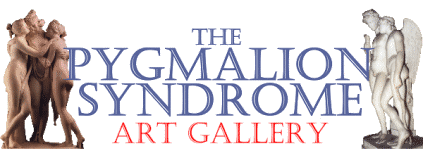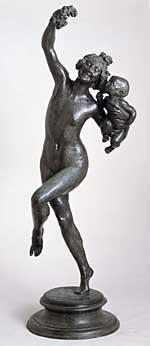
Frederick MacMonnies, Bacchante
and Infant Faun, 1893. Bronze, 213.4 x 75.6 x 80 cm (84 x 29 3/4 x
31 1/2 in.). Metropolitan Museum of Art, New York, Gift of Charles F.
McKim, 1897. Photo by Jerry L. Thompson, (c) 1999 The Metropolitan
Museum of Art, New York
 |

Baldwin Coolidge, Boston Public
Library Building, Dartmouth Street facade with Boylston Street
carriage entrance at right, ca. 1896. Courtesy of the Boston Public
Library, Print Department
 |
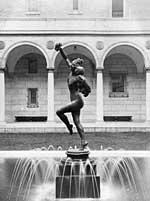
Photographer unknown,
Bacchante Installed in Courtyard Pool, 1896. Courtesy of the
Boston Public Library, Print Department
 |
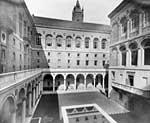
Photographer unknown, Courtyard of
the Boston Public Library, ca. 1896. Courtesy of the Boston Public
Library, Print Department
 |
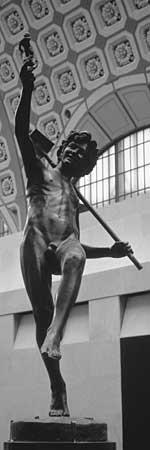
Hippolyte-Alexandre Julien Moulin,
A Lucky Find at Pompeii. 1863. Bronze, height 188 cm (74 in.).
Courtesy of the Musée d'Orsay, Paris. (c) Photo RMN Jean Schormans
 |
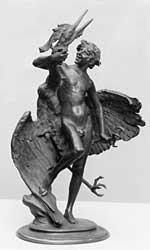
Frederick MacMonnies, Young Faun
with Heron, ca. 1890, bronze, height 70 cm (27 3/4 in.). Courtesy
of the Metropolitan Museum of Art, New York
 |
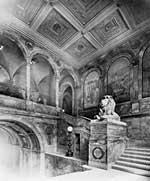
Photographer unknown, Grand
Staircase, Boston Public Library, ca. 1900. Courtesy of the Boston
Public Library, Print Department
 |
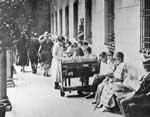
Photographer unknown, Summer
Reading in the Courtyard, ca. 1920. Courtesy of the Boston Public
Library, Print Department
Baldwin Coolidge, Boston Public Library,
ca. 1896. Courtesy of the Boston Public Library, Print Department
 |
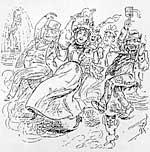
"Bacchante Skip Will Be the Rage:
The Lame, the Halt and Blind Will Make This Their Fad Now That the
Statue Has Been Accepted," Boston Journal, 18 November 1896.
Reproduced Walter Whitehill, "The Vicissitudes of Bacchante in
Boston," New England Quarterly 27 (December 1954), p. 442
 |
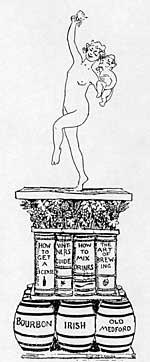
"A Suggestion for a Pedestal for
the Bacchante," scrapbook of newspaper clippings, 3 January 1895 to 25
January 1897, from trustees Library, Boston Public Library. Reproduced
in Walter Whitehill, "The Vicissitudes of Bacchante in Boston,"
New England Quarterly 27 (December 1954), p. 443
 |
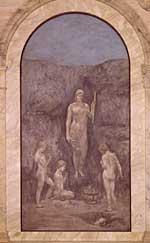
Puvis de Chavannes, Chemistry
, 1896. Oil, 435 x 220 cm (171 1/4 x 86 5/8 in.). Courtesy of the
trustees of the Boston Public Library and the Straus center for
Conservation
|
"Debauched," "vice-ridden," a memorial to "reckless abandon" and "the
worst type of harlotry"-these were among the vehement denunciations hurled
at Frederick MacMonnies' bronze statue Bacchante and Infant Faun.
What triggered these remarks in the fall of 1896 was the donation of the
statue-a three-quarter life-size female nude in midskip holding a cluster
of grapes in one hand and a young child in the other-for the fountain in
the courtyard of the recently completed Boston Public Library. Charles F.
McKim, the donor (as well as the widely respected architect of the library
itself) had intended MacMonnies' work to unify the building with the
courtyard. But in the end, the seemingly innocuous bronze statue succeeded
only in dividing Boston society, sparking a major civic battle.
For over a year, controversy brewed as opponents fought to expel the
American sculptor's skipping nymph from the city and supporters fought
just as ardently to keep it. One incensed opponent in a public talk
entitled "treason in the Boston Public Library," went so far as to accuse
library trustees who defended the statue of "treason to purity and
sobriety and virtue, and Almighty God."1
The trustees, like McKim and other Boston citizens, regarded such
accusations as reactionary and uninformed. By November, the debate over
the statue had reached a fevered pitch. Thomas Sullivan, a Boston
playwright, described the controversy in his journal:
Both cats have their backs well up, and the fur is likely
to fly before the spring comes. . . . We [Sullivan and other supporters]
hope to overwhelm the howling dervishes by our numbers, if not by
rational arguments. Against [the statue] are arrayed President Eliot
[of] Harvard University, Professor Norton, Robert Grant, Barrett
Wendell, and others, who regard it as "a menace to the Commonwealth."
Their allies, the sensational clergy, go a few steps further, and
declare that this begins a righteous crusade against the intolerable
indecencies of the antique in the Art Museum. Verily, impropriety makes
strange bedfellows!2 Through
the winter and spring of 1897, local citizens organized meetings for and
against the statue, petitions and counter-petitions were filed, and
newspapers in Boston and in cities across the country took up positions.
Articles on the latest developments in the uproar appeared regularly in
papers from Los Angeles to Milwaukee to Philadelphia.
One incensed opponent in a public talk
entitled "treason in the Boston Public Library," went so far as to accuse
library trustees who defended the statue of "treason to purity and
sobriety and virtue, and Almighty God."
In the course of these exchanges, MacMonnies' statue assumed two
distinct personalities. For the president of the library trustees, the
Bacchante was "simply glorious, a beautiful work of art." Other
supporters similarly described the work as an innocent expression of grace
and joy. But while they praised the Bacchante for its vital image
of life and delighted in what McKim called the "spirit of joyousness and
spontaneity," opponents denounced the sculpture as a wanton woman,
"unclothed, unquiet, and vile." In the words of one expert appointed by
the Boston Art Commission, the work portrayed no innocent joy but only "a
drunken revel of debased civilization." Critics personified the statue so
frequently that she even acquired a voice of her own. A New York paper
imagined hearing the Bacchante's poetic lament: "Although I have a
joyous air / I'm feeling rather sad / When I am so divinely fair / How can
they call me bad?"3
But the endorsement of the library trustees and later the art
commission, as well as the groundswell of popular support, was not enough
to secure a place for the statue in Boston. The trustees had
enthusiastically accepted McKim's gift in July of 1896 when he offered the
work. Such acceptance was conditional, however, because all public works
of art had to win the approval of the city's art commission. That summer,
the trustees submitted a smaller model of the Bacchante to the
commission for evaluation. At first, it voted against the statue after
conferring with a committee of experts. Then, the commission reversed
itself and accepted the work, prompting those opposed to the
Bacchante to fight all the harder. In June of 1897, after months of
bitter attacks, the commission moved once again to reject the
Bacchante. Charles McKim reported to a colleague that "petitions
were circulated by a certain element in the [Boston] community, which
chose to find in Macmonnaies' [sic] masterpiece that which neither the
trustees nor the Art Commission were able to discover, and which
Macmonnaies never intended." Chagrined and dismayed by the references to
the statue's unsuitability and degeneracy, McKim took back the statue to
save himself and the library trustees any further humiliation. In June he
offered it to the Metropolitan Museum of Art in New York City-which
immediately accepted.4
What so powerfully disturbed particular Boston citizens about the
Bacchante and gave common cause to groups that otherwise had little
to do with one another? Many critics at the time, especially those in
other cities, ascribed the commotion to Boston prudery and primness, and
they endlessly ridiculed Boston (their own apprehensions about the public
display of nudity no doubt fanning the flames). As the New York Sun
put it, "The people there [in Boston] do not believe that such trifling
with the terrible gravity of life as the Bacchante delighted in is proper.
They don't do it themselves, and they object to anybody's doing it or
having done it." Modern scholars have also tended to regard the incident
as a less enlightened moment in Boston's relationship with the
arts.5
This, however, is not the full story. The battle over the
Bacchante exposes fundamental issues about civic control and the
organization of public space in the late nineteenth century. The furor the
statue caused had less to do with squeamishness over nudity or overzealous
sobriety than with competing claims to social legitimacy. The opposition
to the statue expressed both by antivice and religious organizations,
typically of middle- and upper-class membership, and by key figures of
Boston's Anglo-Saxon, Protestant elite suggests deep anxiety over changing
identities and shifting hierarchies within the city. These groups fought
the sculpture not so much because they found it offensive as because they
feared its potential corrupting power over others; it would become a
catalyst to social anarchy. Perhaps more accurately, opponents to the
statue saw in it a challenge to a moral and social hierarchy whose
existence shored up their waning political power. Behind a seemingly
decorative bronze Bacchante lurked a basic question: Whose civic
values would shape public life?
These groups fought the sculpture not so
much because they found it offensive as because they feared its potential
corrupting power over others; it would become a catalyst to social
anarchy.
By proposing to set the bronze in the Boston Public Library, McKim and
his supporters unwittingly thrust the Bacchante into the center of
contemporary debates over women's roles, the position of an Anglo-Saxon,
Protestant elite, and the proper nature of leisure activities.
Turn-of-the-century public works of art, as the Bacchante story
suggests, played a pivotal role in struggles by competing classes and
ethnic groups for social and political expression.
Joyous Nymph or Wanton Woman?
From the beginning, McKim thought he had presented to the city
of Boston a splendid gift. Not only had the Bacchante been well
received upon its completion in 1893, but MacMonnies himself had earned by
the early 1900s numerous awards and commissions, both in Paris where he
studied and worked and in the United States. One of his most renowned
projects was the Barge of State fountain, the sculptural
centerpiece at the Chicago World's Fair of 1893. In designing the Boston
Public Library, McKim had planned a courtyard fountain as a memorial to
his recently deceased wife. When he received the statue from Frederick
MacMonnies-a thank you for the architect's generosity in helping finance
the young sculptor's first study trip to Paris back in 1884-McKim
rejoiced, believing that he had found the perfect complement to his
Renaissance, palazzo-style building.
Artists and audiences on both sides of the Atlantic found much to
applaud in MacMonnies' conception. When it first went on display in Paris
at the Salon of 1894, the work met critical acclaim. Impressed with the
Bacchante, the French government contacted the sculptor about
purchasing it for the Luxembourg Museum-a singular honor for an American
artist. (Having already promised the statue to McKim in June, MacMonnies
made a replica for the Luxembourg.) Encouraged perhaps by the reception in
France, MacMonnies began making reductions of the Bacchante in
1895, which were exhibited and sold in the States. American art critic
Royal Cortissoz singled out the statuette for praise, declaring after a
New York showing: "It is deft, compact, a little triumph of concision, yet
it has all the expansive grace, all the intimations of endless movement,
which belong to a dancing figure."6
By proposing to set the bronze in the Boston
Public Library, McKim and his supporters unwittingly thrust the
Bacchante into the center of contemporary debates over women's
roles, the position of an Anglo-Saxon, Protestant elite, and the proper
nature of leisure activities.
Two of America's most prominent sculptors, Daniel Chester French and
Augustus Saint-Gaudens, greatly admired the statue. Saint-Gaudens, writing
to a French friend after seeing the Bacchante (presumably one of
the reductions exhibited in New York) spoke of the deep impression that it
had made on him and proclaimed it a masterpiece, "the dernier mot
of grace and life. No one had ever done better. No one will ever do
better." Solicited by the Boston Art Commission for their expert opinions
less than two years later, Saint-Gaudens and French both sent letters of
support in the summer of 1896. They wrote again in the fall after the art
commission's initial rejection of the statue, expressing dismay at the
decision and urging reconsideration. They emphasized that the name
"bacchante" and its allusion to Greek mythology and the god Bacchus should
not prejudice the Commission.7
In employing a mythological theme, MacMonnies' statue drew on works by
nineteenth-century French sculptors. To demonstrate the Bacchante's
distinguished genealogy, Saint-Gaudens had specifically mentioned in his
June letter to the commission a series of Pompeiian bronzes by various
artists. He had pointed out that the Bacchante and Infant Faun
echoes, for example, the pose of Hippolyte-Alexandre Julien Moulin's A
Lucky Find at Pompeii, which won a medal at the Salon of 1864, and the
Hunting Nymph (1884), exhibited in 1884, 1885, and 1888, by Jean Alexandre Falguière, one of MacMonnies' teachers in Paris.8
Like Moulin and Falguière, MacMonnies avoided a strictly columnar or
vertical composition in favor of a more open and lively one with the
extension of limbs and counterpoint balance; the Bacchante, on
tiptoe, arches slightly backward and to the side, left leg bent, right arm
outstretched. Like Falguière, MacMonnies also explored mythological
subjects in his work; his Diana won him an honorable mention at the
Salon of 1889. In the 1890s, he executed not only Bacchante and Infant
Faun but also Pan of Rohallion, Running Cupid, and Young Faun with Heron, a laughing young boy wrestling a large heron that
MacMonnies made for Joseph Choate's estate in Stockbridge, Massachusetts,
and showed in the salon of 1890. In their emphasis on movement and
playfulness, these works recall a French tradition of lighthearted
sculptural figures such as those with a fisherboy theme by François Rude, Francisque-Joseph Duret, and Jean-Baptiste Carpeaux.
It was the vitality of the work that struck advocates of the
Bacchante as its great charm, the feature that made it a highly
decorative and desirable addition to the courtyard of the Boston Public
Library. As one critic commented, McKim and MacMonnies "will give Boston
one of the few admirable examples of imaginative sculpture in public
places in America." Although the courtyard was shielded from the street,
large windows on the upper floors of the library looked out onto the
grassy inner sanctum. Visitors could also stroll into the courtyard either
directly from the carriage entrance on Boylston Street or through the
Grand Staircase via the Dartmouth Street doors to stretch their legs,
relax, read, and enjoy the outdoor pool and fountain.9
Approval for the Bacchante ran high among Boston citizens. A
local poll showed majority acceptance, and after the statue went on public
display at the library in November 1896, the local papers, from the
Boston Evening transcript to the Boston Herald and the
Boston Post, all reported that among the great number of viewers
nobody appeared to be offended. '"Not so bad after all!' sighed the crowd
rather disappointedly," one reporter for the Boston Record wrote.
As the Herald noted, many who came "prepared to see a figure that
was inappropriate to the courtyard of the Public Library were struck by
its beauty and fitness for the fountain." Viewers admired the statue as a
joyous image of life, and many demanded that democratic procedures should
determine the fate of MacMonnies' nymph; if the majority of Boston
citizens approved, then the sculpture should stay.10
Viewers admired the statue as a joyous image
of life.
For other Bostonians, however, the Bacchante represented nothing
less than "a menace to the Commonwealth." Leading the charge was a
formidable set of Boston figures, among them Harvard President Charles W.
Eliot, Harvard professors and critics Barrett Wendell and Charles Eliot
Norton, and Judge Robert Grant. All were men of impeccable social status,
perfect examples of Boston Brahmins-a relatively homogenous, Anglo-Saxon,
Protestant elite that had perpetuated itself over generations through
family ties, old money, and multi-faceted involvement in the political and
cultural institutions of the city. What they shared with the other major
anti-Bacchante bloc, the religious and antivice organizations such
as the Watch and Ward Society and the Women's Christian Temperance Union
(WCTU), was the conviction that the act of looking had the power to
transform human behavior. Both groups shared a confidence in the ennobling
and moral influences of art.
This set of allies repeatedly referred to MacMonnies' Bacchante
as inappropriate and unsuitable. They stressed a "want of sympathy"
between the bronze and its library setting. A letter in the Boston
transcript asked, "What are we showing our children? What kind of
moral instruction?" Nudity, Barrett Wendell and other leading Brahmins
insisted, was not the problem. What was objectionable about the
Bacchante, in the words of Robert Grant, was "the artistic
unworthiness of the entire composition as a keynote to the [library]-a
place in an educational sense sacred and which should be reserved for a
work of art intrinsically noble." A Boston Post article, "Honors
Immorality, Library No Place for It," quoted the objections of various
temperance activists, to the effect that the statue, if placed in the
library, would inevitably be a bad, if not dangerous, influence. Charles
Eliot Norton echoed this concern when he remarked "to a public who look
not always from an artistic standpoint, more harm is apt to be worked
than good."11
Such statements hinged on a certitude that what people saw in a work of
art had the power to affect their behavior-for better or for worse. From
this perspective, uplifting visual models not only reinforced but were
also required by the educational mission of the library.
Public Space/Public Interests
By the late nineteenth century, public libraries were heralded as
an instrument for social reform. Members of the public library movement,
underway since 1876, looked to this public venue as a potential solution
to pressing social problems such as alcoholism, penury, and the
assimilation of diverse ethnic groups. Stocked with collections of good
reading materials and fine art, libraries provided patrons with resources
to improve themselves, to become better, more responsible citizens. A
prominent librarian summed up this view: "Free corn in old Rome bribed a
mob and kept it passive. By free books and what goes with them in modern
America we mean to erase the mob from existence." For library proponents
and Boston Brahmins, the "public" in public institution did not imply an
open place in which to congregate or bring together heterogeneous groups
as we might think of such a site today. What mattered was not fulfilling
an individual desire but absorbing prescribed communal values (in this
case determined by a political and social elite).12
Spurred by a belief in public libraries to mold an edifying civic
culture-or, as art historian Sally Promey has noted in her study of the
library's John Singer Sargent murals, to promote democracy through
education -Boston city officials in the late 1880s had drawn up plans for
a grand, new building. Their efforts resulted not only in one of the
largest public libraries in the country but also in an impressive union of
architecture, painting, and sculpture: an environment to inspire both
heart and mind. The inscription above the main entrance on the Dartmouth
Street side, which read "The Public Library of the City of Boston Built by
the People and Dedicated to the Advancement of Learning," beckoned
visitors, who entered the library through massive bronze portals that
opened onto a grand marble staircase guarded by two sculpted lions. An
imposing barrel-vaulted reading room, 218 feet long, 42 feet wide, and 50
feet high, served library patrons. Throughout the building, elaborate
mural cycles by some of the era's most prominent artists decorated the
walls and ceilings. Sargent, for example, depicted the history of religion
in the vaulted hall of the third-floor gallery, while the legend of the
Holy Grail by Edwin A. Abbey ornamented the Book Delivery Room. The French
painter Puvis de Chavannes illustrated the realms of human knowledge along
the walls of the Grand Staircase.13
What mattered was not fulfilling an
individual desire but absorbing prescribed communal values (in this case
determined by a political and social elite).
In its union of texts and images, the library was meant to offer a
complete aesthetic experience. Frederick M. Crunden, an active member and
past president of the American Library Association, elaborated on the
beneficial role of a library building: "Is not its mere beholding
educative and inspiring? Can the thousands who see it every month fail to
imbibe a truer taste for beauty? And is not a pervading love of beauty one
of the corner stones of civic improvement?" When the new Boston Public
Library opened its doors in 1895, New York art critic Mariana van
Rensselaer described it as a "civic monument," and of the courtyard in
particular, she wrote that it was "a place owned by the public of a great
city, where hours or even moments of repose or study will be doubly
fruitful, feeding the most careless or unconscious eye with the food of
high artistic loveliness."14
Dubbed a "palace for the people," the library could equally have been
termed a temple of refinement, a secular counterpart to the church.
The Boston Public Library was not alone in its cultural mission. A
network of upper-class institutions dedicated to the arts had emerged
within the city. Beginning in the 1870s, in response to popular political
assaults on Brahmin institutions and the flow of immigrants (with their
seemingly improper social customs) into Boston, the city's elite had
attempted to strengthen itself by erecting cultural barriers. Unlike the
upper classes in New York and Philadelphia, which concentrated less of
their money and effort on cultural enterprises, Boston leaders, as
sociologist Paul Dimaggio has written, "retreated from the public sector
to found a system of nonprofit organizations that permitted them to
maintain some control over the community even as they lost their command
of its political institutions." Both the Boston Museum of Fine Arts and
the Boston Symphony, for example, were founded in this period. Although
the public library helped to consolidate elite social structures, it
especially reached out to a lower-class constituency. The institution's
middle and upper-class backers had high hopes that the library would
counter what they perceived as the dangerous influence of establishments
such as the saloon. Concerns about the use of alcohol and leisure time
indeed made the Bacchante controversy all the more explosive.15
In the bourgeois world of the late nineteenth century, the library and
the saloon represented opposing moral and social poles. Associated with
alcohol and often called the "workingmen's club," the saloon was
essentially a stronghold for immigrant as well as popular culture. By the
1890s, middle- and upper-class temperance groups such as the WCTU,
Boston's Citizens' Law and Order League, founded in the 1880s, and the
Anti-Saloon League, which came into force in the mid-1890s, launched a
frontal attack on places of drink, using the law to regulate alcohol
consumption and hours of business. Battles over the saloon's existence, as
historian Roy Rosenzweig has noted, "often took on aspects of a 'class
war' over the recreational world of the industrial working class."
Although saloons provided certain amenities such as socializing space that
were not readily available elsewhere in public, from a temperance
perspective, saloons meant alcohol, and alcohol was a scourge. Middle- and
upper-class ideals about leisure time and family life clashed with the
circumstances of immigrant life and lower-class uses of urban areas.16
For proponents, libraries offered social comforts but without the
alcohol. In the civilizing space of the public library, patrons imbibed
culture, not booze. That libraries and bars met the same social needs and
could be easily exchanged, and would be by those given the choice, was
presumed. Crunden, the passionate spokesman for the library association,
explicitly described the library's role as antidote to the saloon: "It is
fair to assume," he wrote, "that saloons and resorts of a demoralizing
character . . . are nightly frequented by men and boys who would go to a
free reading room, if one were found. . . . Prohibition will not do:
substitution is the true remedy."17
Libraries, from this perspective, extended the work of public schools.
They assumed the role of literary shepherd, guiding their flock to the
wholesome pastures of the written word. The library, envisioned as a
structure of enlightenment, and the saloon, a site of iniquity, thus stood
at opposite ends of the cultural spectrum. To place what temperance
activists saw as a vice-ridden figure in the central courtyard, the heart
of the public library, meant the symbolic transfer of the saloon into the
library, a gesture that contravened every principle for which they were
fighting.
The institution's middle and upper-class
backers had high hopes that the library would counter what they perceived
as the dangerous influence of establishments such as the saloon.
While the grapes the Bacchante holds, her pose, and her title do
not necessarily convey drunkenness or licentiousness, the image, as a
whole, does not strongly counter such associations. The statue, in the
eyes of its opponents, left too much open to individual interpretation,
particularly the role of women. Temperance unions such as the WCTU saw
women as defending one of the bastions of moral society, the home, and
viewed the abuse of alcohol as a serious threat. Drinking squandered
precious family funds and disrupted family relationships in part by
encouraging greater sexual freedom. The Women's Christian Temperance Union
consequently centered its temperance activities around "home values," or
more generally what it called the "white life." An attempt to fortify
women's authority both inside and outside the home, living the white life
meant, as historian Barbara Epstein has noted, "elevating the position of
women by placing restraints on sexuality, supposedly a primarily male
interest, and valorizing the moral role of women in family and society."18
The statue's lighthearted air thus strained against Victorian notions
of public female behavior, according to which a good woman was modest and
responsible. Chavannes's partially nude figure of Chemistry,
painted in the large entryway of the library, for example, constituted a
traditional and acceptable display of the female form: nudity cloaked by
allegorical context. An image of civilized society, she represents
rational, scientific endeavor and humankind's successful efforts to
domesticate natural forces. The deployment of the figure-solid, columnar,
and balanced-underscores that control. This sense of discipline was
equally true for other nude statues like those of Venus that graced the
library halls. The copy of Venus de Medici, prominently placed in a
corridor to the Children's Room, had a contained pose: feet together, arms
modestly placed before her body, gaze averted.
By contrast, MacMonnies' Bacchante portrays female nudity
without the shield of edifying allegory. And there is no pretense toward
modesty or restraint; her open arms, her wide grin, and her head thrown
back express pure delight. The lively composition and MacMonnies'
naturalistic rendering of her head further distance the statue from the
safe haven of the idealized world. Not only does she sport a loose,
unstyled hairdo, but her face appears realistic, so much so that
newspapers at the time consumed much ink speculating about the identity of
the model. Free-spirited and exuberant in her nakedness, the
Bacchante touched nerves made raw not only by shifting attitudes
toward the use of alcohol but also by changing women's roles. In short, to
install the statue in the courtyard would have meant for some the collapse
of cultural and civic order. An article in the Boston Globe
expressed it most bluntly: "[T]he vices which fill our prisons should not
be exalted in our library."19
Civic Order and Social Distinctions
In challenging mores, the Bacchante threatened to
collapse boundaries between elite and mass purviews. An incident involving
the Boston Public Library before its move to the new building in 1895
illuminates the reliance of Boston citizens on class codes and their
sensitivity to social position. Several local papers released a story in
1892 that the library was not planning to arrange for a separate space for
the collection of popular books and magazines housed in the old library's
"Lower Hall." The Boston Globe wrote of the "indignities" that the
Lower Hall readers-a lower-class constituency-would suffer if they had to
go to "the [new] enormous Bates Hall along with everyone else, and rub
elbows with the Beacon st. [sic] swell, the teacher, and all varying
classes of people who are now accommodated in the [old] Bates Hall,
upstairs, and are away from the plain people, who are glad to avail
themselves of the 'lower hall.'"20
The Brahmin charge of inappropriateness raised against the sculpture
spoke to fears about the absorption of lower-class and, by extension,
immigrant groups into Boston society and the potential upending of the
city's social stratification. Associated as they often were with
drunkenness and crime, the immigrant working class appeared to constitute
a social powder keg. At the height of the Bacchante controversy,
for example, the Boston Evening transcript ran an article arguing
for a correlation between alcohol consumption and crime, pauperism, and
insanity. In listing the statistics for each category, the report broke
down figures into "citizen born" and "alien"; percentages ran
significantly higher for the latter.21
The Brahmin charge of inappropriateness
raised against the sculpture spoke to fears about the absorption of
lower-class and, by extension, immigrant groups into Boston society and
the potential upending of the city's social stratification.
The immigrant group that appeared to pose the greatest threat to the
social hierarchy was the Irish. Middle- and upper-class perceptions of
them focused on their poverty and the supposed inability of even
American-born Irish to be productive. Magazines such as Atlantic
Monthly and Century, for instance, circulated reports about the
degeneracy of second-generation immigrants. Catholic and culturally
distinct, the Irish had started arriving in Boston in the 1840s; by 1895,
estimates put the Irish population in the city at 60 percent. The Irish
had increasingly exercised their electoral muscle, challenging the
political hegemony of Boston's upper class. In 1884, for example, for the
first time, an Irishman became mayor; from 1900 on, the Irish would
consistently control the mayoralty. In the face of their move into
political life, many of Boston's Anglo-Saxon, Protestant elite had felt
themselves and the values they believed in under assault by an alien people.22
The remarks of Bacchante opponent Charles Eliot Norton just
after the statue's expulsion registered the level of tension and unease
particularly among Boston's Brahmins. Norton declared in an 1897 letter,
"I fancy that there has never been a community on a higher and pleasanter
level than that of New England during the first thirty years of this
century, before the coming in of Jacksonian Democracy, and the invasion of
the Irish."23
For many of Boston's elite, the Irish continued to be viewed as outsiders,
dangerous and impossible to assimilate.
A Boston newspaper cartoon, entitled "A Suggestion for a Pedestal for
the Bacchante," suggests how deeply the debate over the statue and its
placement into public space tapped into contemporary class and ethnic
conflicts. Although ambiguous in its stance toward MacMonnies' statue, the
cartoon categorized types of alcohol to set up a clear visual hierarchy.
With the harder alcohols at the bottom of the pedestal is Irish whiskey.
Four books occupy the middle tier. With titles such as Vinter's
Guide and The Art of Brewing, they suggest a middle class with
more refined taste. A layer of lush grape leaves, a reference perhaps to a
natural order, leads to the top of the pedestal. Above stands the
Bacchante herself holding a cluster of grapes, the union of art and
discriminating taste that could be interpreted as representing an
upper-class elite.
In the climate of 1896-a time of deepening recession, extreme labor
unrest, the rise of a populist movement in the West, and agitation for a
silver standard that galvanized the presidential election debates that
year-signs of unconventional behavior and nontraditional values proved
especially intimidating. From an upper-class perspective, an
unsophisticated public might see in an officially sanctioned sculpture
that broke the bounds of convention and freed inhibition a license for
irregular behavior. Another cartoon, this one from the Boston
Journal in November 1896, entitled "Bacchante Skip Will Be the Rage:
The Lame, the Halt and the Blind Will Make This Their Fad Now That the
Statue Has Been Accepted," illustrates the possible chaos and loss of
control that the statue could inspire. A crudely drawn Bacchante
lurks in the left corner of the cartoon. Imitating her pose, a cross
section of Boston citizens prance down the street, arms thrown above their
heads, legs kicked out in front of them. Even the animal kingdom gets
mixed up in the potential anarchy, as the little dog in the drawing
suggests.
From an upper-class perspective, an
unsophisticated public might see in an officially sanctioned sculpture
that broke the bounds of convention and freed inhibition a license for
irregular behavior.
To immortalize in bronze and enshrine in a public space-a public
library, no less-a statue that the elite saw as legitimating civic
disorder was tantamount to backing that class's own demise. Impelled to
fight against the statue, Boston's prominent fastened on the question of
suitability. By establishing themselves as purveyors of good taste, they
staked out cultural ground. From their position, the Bacchante,
while perhaps artistic, failed to edify or uplift enough. The
Bacchante incident speaks to ways of seeing and the mediation
through art of social tensions. Opponents described the statue as
intoxicated, but sympathetic viewers, including a library janitor who had
helped to install the statue, saw nothing of the kind. A columnist who was
favorably inclined toward the statue, for example, pointed out a fallacy
in the argument of the opposition: "No one . . . who has made the
slightest study of the outward symptoms of inebriety could charge this
Bacchante, who is standing on the tip of one toe and carrying a baby
safely and comfortably on one shoulder, of being under the influence of
the bunch of grapes which she dangles over the baby's
mouth."24
The conflicting visions of MacMonnies' statue as "wanton woman" or
"joyous nymph" underscore the role that public space played in regulating
social interaction. The art that shaped such space participated in that
process. In the fall of 1896, opponents saw danger stalking in the form of
a bronze Bacchante. The efforts by both a Brahmin elite and
temperance and antivice groups to consolidate their own social position,
as well as prescribe a cultural model for alien, lower-class groups, made
issues of appropriateness and abstinence-and by extension the
Bacchante itself-symbolically loaded. Alone, the crusade
organizations might not have been enough to banish MacMonnies' statue. But
the union of moral mission and social authority translated into clout. By
the summer of 1897, enough pressure had been exerted to convince McKim to
abandon his vision for the courtyard fountain. Perhaps the most telling
event of the Bacchante debacle is a coda to the uproar. Several
years later, a Boston collector purchased a bronze replica of the statue
and presented it to the Boston Museum of Fine Arts. No one raised the
slightest fuss. In the confines of an elite institution, dedicated to
artistic taste and high culture, the Bacchante's blissful abandon
could cause no harm.
Brahmin leaders, like the antivice groups, sought to mold a public in
their own image, and they turned to art and culture to transmit and
inculcate the values they esteemed. The expulsion of the MacMonnies'
Bacchante marked a small victory in a campaign waged by upper-class
elements stretching back to the 1870s to resist the increasing
transformation of public life. As Barrett Wendell, one of the social
elite, commented several years after the incident, "[T]he future of our
New England must depend on the standards of culture which we maintain and
preserve here. The College, the Institute, the Library, the Orchestra . .
. are the real bases of our strength and dignity in the years to come."
With the rejection of the statue in 1897, Wendell could claim that, for
the moment, those standards had been preserved. But the lead of a social
elite presumed, of course, a people compliant and desiring guidance. By
the end of the late nineteenth century, patrician dominance was giving way
to mass politics and competing claims to cultural expression. MacMonnies'
Bacchante arrived in the city as the terms of "the public"
were being challenged and reconstituted.25
The expulsion of the MacMonnies'
Bacchante marked a small victory in a campaign waged by upper-class
elements stretching back to the 1870s to resist the increasing
transformation of public life.
A century later, the perceived role of public space has altered
the reception of the Bacchante yet again. In 1992, Boston's Art
and Humanities commissioner and library trustees welcomed the statue back
to its originally proposed site, the courtyard of the Boston Public
Library. As Commissioner Bruce Rossley stated, "We want to erase an error
of [a hundred] years ago and fulfill McKim's courtyard vision." The
fountain pool will have its sculpture once renovations to the courtyard
are completed this November.26
MacMonnies' Bacchante carries for an early twenty-first century
audience principally aesthetic significance-the crowning feature of a
grand architectural design. We wonder today what all the fuss had been
about.
Notes
This article has benefited greatly from the insights and guidance of a
number of people whom I would like to acknowledge. I am especially
grateful to Elizabeth Johns, who not only shepherded but inspired me
through the early stages of research. During the writing of the project,
Vivien Green Fryd and Sally Promey offered much appreciated encouragement
and suggestions, and I am indebted to Sven Beckert and Emily O'Brien for
their incisive criticisms on later versions of the manuscript. Finally, I
would like to thank John Dorsey of the Boston Public Library along with
the fine arts research librarians there and librarian John Campbell at
Harvard University for their invaluable assistance.
1 Reverend James Brady, "treason in the Boston Public Library,"
Boston Globe, 23 November 1896, scrapbook of newspaper clippings, 3
January 1895 to 25 January 1897, trustees Library, Boston Public Library.
2 Thomas R. Sullivan, Passages from the Journal of Thomas
Sullivan, 1891-1903 (Boston: Houghton Mifflin, 1917), p. 189.
3 The remarks by the president of the library trustees, Frederick
Prince, are quoted in Walter M. Whitehill, "The Vicissitudes of
Bacchante in Boston," New England Quarterly 27 (Dec. 1954):
449. For McKim's letter to the library trustees of 6 July 1896, see art
correspondence file, trustees Library, Boston Public Library. See also "At
Intervals," Boston Evening transcript, 22 October 1896, p. 6, and
the letter of Herbert L. Warren, 1 August 1896, correspondence file of the
Boston Art Commission, Boston City Hall. The poem appeared in New York
Town Topics, 10 June 1897, Frederick MacMonnies Papers, Archives of
American Art, roll D245, F80.
4 Letter of 1 June 1897 to Metropolitan Museum trustee Frederic
W. Rhinelander, Charles McKim file, Metropolitan Museum of Art Archives.
5 Quoted in Whitehill, "Vicissitudes Bacchante," p. 440.
In a show of journalistic mudslinging and regional rivalry, the Boston
Evening transcript 24 October 1896 (p. 16) indignantly responded to
what it called the "blackguarding of Boston" by the New York Sun:
"The Sun has been morally perverted and bent on public mischief for
more than twenty years. . . . So nobody knows whether the Sun is
serious in a given matter and nobody really cares." For current
scholarship, Tom Armstrong, et al., 200 Years of American Sculpture
(New York: Whitney Museum of American Art, 1976); Albert TenEyck Gardner,
American Sculpture: A Catalogue of the Collection of the Metropolitan
Museum Art (Greenwich, Conn.: New York Graphic Society, 1965);
Hildegard Cummings, "Chasing a Bronze Bacchante," Bulletin of the
William Benton Museum of Art 12, University Connecticut (1984): 3-19,
as well as Mary Smart, A Flight with Fame: The Life and Art of
Frederick MacMonnies (Madison, Conn.: Sound View Press, 1996). Joy S.
Kasson in Marble Queens and Captives: Women in Nineteenth-Century
American Sculpture (New Haven: Yale University Press, 1990) speaks of
the fraught attitudes of nineteenth-century audiences toward nudity.
6 Cummings in "Chasing a Bronze Bacchante" details the various
reproductions and reductions made of the statue. See Royal Cortissoz,
"Some Imaginative Types in American Art," Harper's New Monthly
Magazine 91 (July 1895): 174.
7 Saint-Gaudens's letter to Paul Bion
cited in Charles
Meltzer, "Frederick MacMonnies-Sculptor," Cosmopolitan 53 (July
1912): 210. Similar compliments appear in letters to the art commission,
21 July 1896 and 26 June 1896, correspondence file of the Boston Art
Commission, Boston City Hall. See also the French and Saint-Gaudens joint
letter of 26 October 1896, correspondence file of the Boston Art
Commission, Boston City Hall.
8 Kathryn Greenthal in Augustus Saint-Gaudens: Master
Sculptor (New York: Metropolitan Museum of Art, 1985), p. 42, compares
Moulin's work with MacMonnies'. Interestingly, Moulin
had found inspiration in an antique sculpture from Pompeii known as Dancing Faun; see The Romantics to Rodin: French Nineteenth-Century
Sculpture from North American Collections, Peter Fusco and H. W.
Janson, eds. (Los Angeles County Museum of Art in association with George
Braziller, 1980), p. 308.
9 W. T. Parker, cited in Whitehill, "Vicissitudes of
Bacchante," p. 438.
10
"Not Bad," Boston Record, 16 November 1896;
Boston Herald, 16 November 1896, scrapbook of newspaper clippings,
3 January 1895 to 25 January 1897, trustees Library, Boston Public
Library.
11
Boston Evening transcript, 10 December 1896, p. 6.
Robert Grant had his protagonist make this comment in his novel The
Chippendales (New York: Scribner's, 1909): p. 365; Boston Post,
13 November 1896, p. 6. Norton's comments appeared in a statement to the
Boston Post on November 16.
12
Josephus N. Larned, "The Freedom Books," Why Do We Need
a Public Library. Library tract, no.1 (American Library Association,
1902): p. 18. also Joseph L. Harrison," The Public Library Movement in the
United States," New England Magazine, n.s., 10 (August 1894):
709-22, as well as such useful histories as Dee Garrison, Apostles of
Culture: The Public Librarian and American Society, 1876-1920 (New
York: Free Press, 1979) Rosemary Ruhig Du Mont, Reform and Reaction:
The Big City Public Library in American Life (Westport, Conn:
Greenwood Press, 1977). In addition, see Richard Sennett, The
Conscience of the Eye: The Design and Social Life of Cities (New York:
Alfred Knopf, 1990), and Jeff Weintraub, "The Theory and Politics of the
Public/Private Distinction," Public and Private in Thought and
Practice: Perspectives on a Grand Dichotomy, Jeff Weintraub and
Krishan Kumar, eds. (Chicago: University of Chicago Press, 1997).
13
Sally M. Promey, Painting Religion in Public: John
Singer Sargent's triumph of Religion at the Boston Public Library
(Princeton: Princeton University Press, 1999), pp. 157ff.
14
Frederick Crunden, "The Public Library and Civic
Improvement," The Chautauquan (June 1906): 336; Mariana van
Rensselaer, "The New Public Library in Boston: Its Artistic Aspects,"
Century Magazine 50 (June 1895): 262.
15
"Cultural Enterprise in Nineteenth-Century Boston,"
Media, Culture and Society 4 (1982): 39-40. On the broader topic of
the "sacralization of culture," see Lawrence W. Levine, Highbrow,
Lowbrow: The Emergence of Cultural Hierarchy in America (Cambridge:
Harvard University Press, 1988), and Pierre Bourdieu, Distinction: A
Social Critique of the Judgment of Taste, Richard Nice, trans.
(Cambridge: Harvard University Press, 1984). On New York City's
bourgeoisie and the consolidation of its political and social power, see
Sven Beckert, The Monied Metropolis: New York City and the
Consolidation of the Bourgeoisie 1850-1900 (New York: Cambridge
University Press, 2001).
16
Roy Rosenzweig, Eight Hours for What We Will: Workers
and Leisure in an Industrial City, 1870-1920 (Cambridge: Cambridge
University Press, 1983): 95. See also Jon M. Kingsdale, "The 'Poor Man's
Club': Social Functions of the Urban Working-Class Saloon," American
Quarterly 25 (Oct. 1975): 472-89. I draw on Stuart Blumin's definition
of the middle class in this period as urban, salaried, and nonmanual
employees. See his The Emergence of the Middle Class: Social Experience
in the American City, 1760-1900 (New York: Cambridge University Press,
1989). Ruth Bordin in Woman and Temperance: The Quest for Power and
Liberty, 1873-1900 (Philadelphia: Temple University Press, 1981) and
John S. Blocker Jr. in American Temperance Movements: Cycles of
Reform (Boston: Twayne Publishers, 1989) discuss the class composition
of WCTU and other temperance groups. As Nicola Beisel has shown,
upper-class individuals typically organized and led antivice movements
such as Boston's Watch and Ward Society, while members came from the
middle and upper classes. See Nicola Beisel, "Class, Culture, and
Campaigns Against Vice in Three American Cities, 1872-1892," American
Sociological Review 55:1 (Feb. 1990): 44-62.
17
Crunden, "The Value of a Free Library," The Library
Journal 15 (March 1890): 80.
18
On the subject of "home values," see Barbara L. Epstein,
The Politics of Domesticity: Women, Evangelism, and Temperance
(Middletown, Conn.: Wesleyan University Press, 1981), as well as
Beisel, Imperiled Innocents: Anthony Comstock and Family Reproduction
in Victorian America (Princeton: Princeton University Press, 1997).
19
Boston Globe, 30 November 1896, p. 7.
20
Boston Globe, 1 January 1892, cited in Whitehill,
Boston Public Library: A Centennial History (Cambridge: Harvard
University Press, 1956), p. 153.
21
"Influence of the Liquor traffic," Boston Evening
transcript, 18 November 1896, p. 6.
22
"The Foreign Elements in Our Population," Century
Illustrated Monthly Magazine, n.s., 6 (Sept. 1884): 765, and H. C.
Merwin, "The Irish in American Life," Atlantic Monthly 77 (March
1896): 289-99. While the Irish in Boston did not tend to translate their
political power into economic or occupational achievement, statistics
suggest that second-generation Irish did do better than their parents; see
Stephan Thernstrom, The Other Bostonians: Poverty and Progress in the
American Metropolis, 1880-1970 (Cambridge: Harvard University Press,
1973), pp.130ff. For an ethnic breakdown of the population, see Geoffrey
Blodgett, The Gentle Reformers: Massachusetts Democrats in the
Cleveland Era (Cambridge: Harvard University Press, 1966), pp. 148-49.
Blodgett's estimate presumably includes first- and second-generation Irish
as well as third and fourth generations. As James J. Connolly notes in
The triumph of Ethnic Progressivism: Urban Political Culture in Boston,
1900-1925 (Cambridge: Harvard University Press, 1998), p. 217, n. 4,
census data from the period show that the number of first- and
second-generation Irish in Boston alone totaled 42.5 percent of the city's
population; if you add third and fourth generations to that, the numbers
would "increase significantly."
23
Letter to Samuel Ward, 14 July 1897, Letters of Charles
Eliot Norton, with Biographical Comment by His Daughter Sara Norton and
Mark Anthony DeWolfe Howe, vol. 2 (Boston: Houghton Mifflin, 1913), p.
254.
24
"The Listener," Boston Evening transcript, 28
October 1896, p. 4. See also the Boston Post, 15 November 1896,
front page.
25
Mark Anthony DeWolfe Howe, Barrett Wendell and His
Letters (Boston: Atlantic Monthly Press, 1924), p. 145.
26
Greg Reibman, "The Bacchante That Got Left Behind,"
Artnews (May 1992): 40. The cast of the sculpture is taken from the
Bacchante at the Metropolitan Museum of Art.
|
